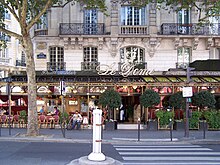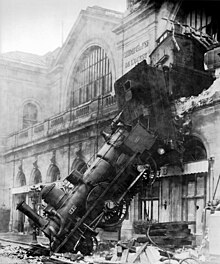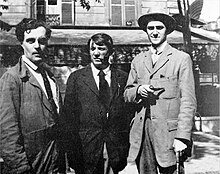Montparnasse
Montparnasse (French: [mɔ̃paʁnas] ⓘ) is an area in the south of Paris, France, on the left bank of the river Seine, centred at the crossroads of the Boulevard du Montparnasse and the Rue de Rennes, between the Rue de Rennes and boulevard Raspail. It is split between the 6th, 14th, and 15th arrondissements of the city. Montparnasse has been part of Paris since 1669.[citation needed]
The area also gives its name to:
- Gare Montparnasse: trains to Brittany, TGV to Rennes, Tours, Bordeaux, Le Mans; rebuilt as a modern TGV station;
- The large Montparnasse – Bienvenüe métrostation;
- Cimetière du Montparnasse: the Montparnasse Cemetery, where, among other celebrities, Charles Baudelaire, Constantin Brâncuși, Jean-Paul Sartre, Simone de Beauvoir, Man Ray, Samuel Beckett, Serge Gainsbourg and Susan Sontagare buried;
- Tour Montparnasse, a lone skyscraper.
Students in the 17th century who came to recite poetry in the hilly neighbourhood nicknamed it after "Mount Parnassus", home to the nine Muses of arts and sciences in Greek mythology. The hill was levelled to construct the Boulevard Montparnasse in the 18th century. During the French Revolution many dance halls and cabarets opened their doors, becoming gathering points for artists. The area is also known for cafés and bars, such as the Breton restaurants specialising in crêpes (thin pancakes) located a few blocks from the Gare Montparnasse.[1] The Pasteur Institute is located in the area. Beneath the ground are tunnels of the Catacombs of Paris.
Artistic hub

In the 18th century, students recited poems at the foot of an artificial hillock of rock rubble from the
The cultural scene during the late-1920s for expatriates in Montparnasse and the 6th arrondissement is described in John Glassco's 1970 book Memoirs of Montparnasse. Virtually penniless painters, sculptors, writers, poets and composers came from around the world to thrive in the creative atmosphere of Montparnasse and for the cheap rent at artist communes, such as La Ruche. Living without running water, in damp, unheated Ateliers, many sold their works for a few Francs just to buy food. Jean Cocteau once said that poverty was a luxury in Montparnasse. First promoted by art dealers such as Daniel-Henry Kahnweiler, today works by those artists sell for millions of euros.


at La Rotonde, by Cocteau, 1916.
In post-

Montparnasse was a community where creativity was embraced with all its oddities, each new arrival welcomed unreservedly by its existing members. When Tsuguharu Foujita arrived from Japan in 1913 not knowing a soul, he met Chaïm Soutine, Amedeo Modigliani, Jules Pascin and Fernand Léger virtually the same night and within a week became friends with Juan Gris, Pablo Picasso and Henri Matisse. In 1914, when the English painter Nina Hamnett arrived in Montparnasse, on her first evening the smiling man at the next table at Café de la Rotonde graciously introduced himself as "Modigliani, painter and Jew". They became good friends and Hamnett later recounting how she once borrowed a jersey and corduroy trousers from Modigliani, then went to La Rotonde and danced in the street all night.
Between 1921 and 1924, the number of Americans in Paris swelled from 6,000 to 30,000. While most of the artistic community gathered here were struggling to eke out an existence, well-heeled American socialites such as

The cafés, bistros and bars of Montparnasse were a meeting place where cultural ideas and connections were hatched and mulled over. The cafés at the centre of Montparnasse's night-life were in the Carrefour Vavin, now renamed Place Pablo-Picasso.
In Montparnasse's heyday (from 1910 to 1920), the cafés Le Dôme, Closerie des Lilas, La Rotonde, Le Select, and La Coupole—all of which are still in business—were the places where starving artists could occupy a table all evening for a few centimes. If they fell asleep, the waiters were instructed not to wake them. Arguments were common, some fueled by intellect, others by alcohol, and if there were fights (and there often were) the police were never summoned. If you could not pay your bill, people such as La Rotonde's proprietor, Victor Libion, would often accept a drawing, holding it until the artist could pay. As such, there were times when the café's walls were littered with a collection of artworks.
There were many areas where the artists congregated, one of them being near Le Dôme at no. 10 rue Delambre called the
The rue de la Gaité in Montparnasse was the site of many of the great

On their stages, using then-popular single name pseudonyms or one birth name only, Damia, Kiki, Mayol and Georgius, sang and performed to packed houses. And here too, Les Six was formed, creating music based on the ideas of Erik Satie and Jean Cocteau.
The poet Max Jacob said he came to Montparnasse to "sin disgracefully", but Marc Chagall summed it up differently when he explained why he had gone to Montparnasse: "I aspired to see with my own eyes what I had heard of from so far away: this revolution of the eye, this rotation of colours, which spontaneously and astutely merge with one another in a flow of conceived lines. That could not be seen in my town. The sun of Art then shone only on Paris."
While the area attracted people who came to live and work in the creative,
The
Economy


SNCF, the French rail company, has its head office in Montparnasse near the 14th arrondissement.[6][7]
Prior to the completion of the current Air France head office in Tremblay-en-France in December 1995,[8][9] Air France had its headquarters in a tower located next to the Gare Montparnasse railway station in Montparnasse and in the 15th arrondissement; Air France had its headquarters in the tower for about 30 years.[10][11][12]
Education
The Vandamme Library (Bibliothèque Vandamme) is located in the neighbourhood.[13][14]
References
- ^ Amanda Mehtala & Arthini Pulenthiran (2018). "Paris Neighborhood Guide: Montparnasse". Theatre in Paris. Retrieved 18 February 2020.
- ^ "Montparnasse". Paris Digest. 2018. Retrieved 13 August 2018.
- ^ Woodhead, Lindy, "War Paint: Madame Rubenstein and Miss Elizabeth Arden, Their Lives, Their Times, Their Rivalry," Wiley, 2004, p. 128
- ^ Montparnasse Déporté: Artisti Europei de Parigi al Lager; published by Elede, 2007, under the auspices of the Musée du Montparnasse, the City of Turin, and the Region of Piemonte (Italy)
- ^ Undzere Farpainikte Kinstler, Hersh Fenster, Imprimerie Abècé, Paris, 1951
- ^ "Legal information Archived 29 May 2012 at the Wayback Machine." SNCF. Retrieved 26 October 2009.
- Les Echos. 20 May 1999. Page 54. Retrieved 1 May 2010. "Pari tenu : réceptionné le 19 mars par Bouygues Immobilier et livré à son occupant dix jours plus tard, le nouveau siège de la SNCF est sorti de la gangue du grand ensemble de la gare Montparnasse, dans le 14e arrondissement de Paris, en quinze mois d'un chantier intense qui a mobilisé sur place jusqu'à 650 personnes. Quelque 800 postes de travail sont concernés sur les 2.500 qui gravitaient hier autour du siège historique de Saint-Lazare (9e arrondissement), consacrant la partition entre une direction générale resserrée et des services centraux pléthoriques."
- ^ "AIR FRANCE HEAD QUARTERS – ROISSYPOLE Archived 11 July 2011 at the Wayback Machine." Groupement d'Etudes et de Méthodes d'Ordonnancement (GEMO). Retrieved 20 September 2009.
- ^ "Roissy Charles-de-Gaulle Archived 13 October 2010 at the Wayback Machine." Tremblay-en-France. Retrieved 20 September 2009.
- ^ Salpukas, Agis (27 December 1992). "Air France's Big Challenge". The New York Times. Retrieved 31 May 2009.
- ^ World Airline Directory. Flight International. 20 March 1975. "466.
- ^ Mlekuz, Nathalie. "Air France vole vers ses avions, destination Roissy Archived 28 February 2019 at the Wayback Machine". Le Monde. 2 April 1997. Retrieved 22 September 2009.
- ^ "Bibliothèque Vandamme[permanent dead link]." City of Paris. Retrieved 22 February 2010.
- ^ "Des livres à domicile pour les seniors." Le Parisien. 11 August 2009. Retrieved 22 February 2010. "la bibliothèque Vandamme de l'avenue du Maine (Montparnasse, XIV e)."
Further reading
- Billy Kluver, Julie Martin. Kiki's Paris: Artists and Lovers 1900–1930. The definitive illustrated account of the golden age of Montparnasse.
- Shari Benstock, Women of the Left Bank: Paris, 1900–1940, University of Texas at Austin, 1986
- Being Geniuses Together, 1920–1930 by Robert McAlmon, Kay Boyle (1968)
